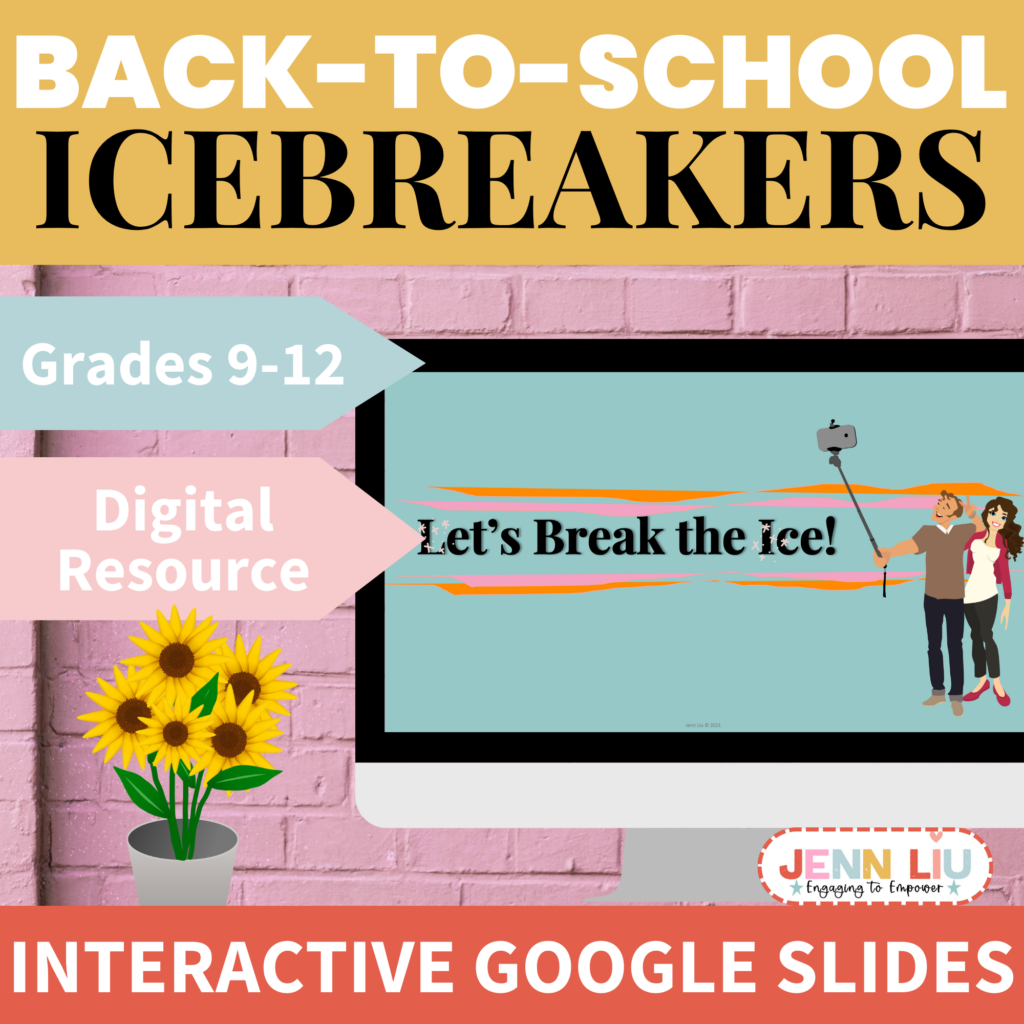At the start of each school year, new teachers everywhere wonder:
With the long list of what I’m supposed to cover, do I just jump into content, lay down the law with my class rules, or start with icebreakers?
Well, of course, class rules are necessary, but as you may have heard, you need to connect before you can correct!
Connecting is crucial to get students to pay attention, respect your rules, and support and learn from each other. And, we all know using class icebreakers is one of the most effective ways to get students comfortable so they’re more inclined to share their ideas and work together.
So yes, definitely start with icebreakers! This is especially important on the first day back to school. The rest can wait.
But here’s the problem:
Most teachers feel pressured to dive into their content and they’ve already played the “name game” or “get-to-know-you BINGO” one too many times.
This is why sometimes we need to be reminded why we should make time for icebreakers. And come up with something fun!
So here’s your reminder:
In a nutshell, icebreakers…
- help students get to know each other better,
- make them more comfortable in your class, and
- build rapport among students.

And the best part is…
After doing a few icebreakers, students enjoy working with and supporting their classmates on assignments, participate more fully in collaborative work, and you have a more productive learning community in your class!
Icebreakers can also wake students up, especially if your classes are in-person and you can allow students to move around. Just keep in mind that icebreakers should also help to relax students. They shouldn’t induce anxieties, so be sure to keep your icebreakers low-risk.
If you look on the Internet for classroom icebreakers, you might find that many of them require students to share personal information. However, students may not be ready to share personal details at the beginning of the year or reveal something “unique” about them. This can be stressful and even embarrassing for teenagers who want to do anything but stand out.
If you don’t want to go with the “name game” or “get-to-know-you BINGO” for the 100th time, and need some low-risk icebreakers, I’m happy to share some of my favorites.
Here are four low-risk icebreakers to get you started:
(I didn’t make them up so you’ve probably heard of some version of these, but if you bookmark this post, you can now easily find them when you need them and you’re having a brain fart, as I often do in my old age.)
- Scavenger Hunt: We played this a few times when my classes were fully in remote learning and it was a great way to wake students up and get them moving away from their computer as they scrambled to find what I called out. This can easily be done in person as you call out for things they might have in their bags or send them around campus to find things. I wasn’t going to mention this activity because it doesn’t really help students to get to know each other better, but it’s fun and very low-risk, and can get students closer if done in teams.
If you want it to be a true icebreaker, you’d have to change it up. For example, you could call it “Gimme-Gimme” and call out questions such as “What are you really good at?” and ask students to write their answers on a personal mini whiteboard (for in-person classes) or shared digital whiteboard (e.g., on Google Slides). If you are in person, you could ask students to show their boards to the class and then move and stand next to the person with the same answer.
Another version of the scavenger hunt is called a Goose Chase. Check out my ideas here. This is soooo much fun!
- Snowball: This one is very simple but still fun. Ask students to write one or two facts about themselves on a post-it or piece of paper, crumple it up, and then throw it to a designated area. e.g., You could all stand in a circle and they can throw their paper ball to the middle of your circle. You can take turns opening a paper and reading aloud what it says. Students then should try to guess who wrote what is read aloud. If you want to extend the activity, you can ask each student to elaborate on what they wrote and allow others to ask questions. For virtual classrooms, students can post their facts on a shared digital whiteboard.
- Temperature Check: You don’t have to stop doing icebreakers after the first day — in fact, you shouldn’t! Keep them going throughout the year to continue to build rapport and check in with students, making sure they feel seen and valued.
Here’s what you could do: At the beginning of class, post a question(s) on the board, in your video conference, web-based platform chat (e.g., as a Google Classroom question), on a class poll, or on a Google Form. Some questions you can ask:
• How’s everything going and why?
• What’s something good that happened to you this week?
• What’s something that has been on your mind?
• If you were stranded alone on an island, what would be your top three must-have items?
• What’s your favorite season and why?
• If you could have a superpower, what would it be and why?
• What’s something you have been working hard on this week?
• Are you an early bird or night owl?
• Put an emoji (or one word) in the chat (or on your paper) to show how you’re feeling.
To have a little more fun with this, you could post the question on an online brainstorming tool, such as Answer Garden, that will generate a word cloud that shows common themes!
If you’re doing this without any technology, then you could just have students write their answer on a blank sheet of 8.5 x 11 paper or mini whiteboard and hold it up for sharing. When you do this in a chat, try using the “chat waterfall” strategy, a way to get everyone to share all at once so no one is influenced by what others say. Ask people to write their answer, and then have students all hit ‘send’ at once. You could also do this on a shared digital whiteboard. You could then read a few responses out loud or have a student read them.
Concentric Circles Version: If there is time and your class is face-to-face, you could have students choose a partner, decide who is A and B, and then have all the A students stand in a circle facing outwards facing their B partner. Then you would call out a question and partners share their answers. When you call time, students on the inside then move counterclockwise to the next person. You can either have them answer the same question or move on to another one.
- Lineup Game: I love playing this game almost as much as my students when I play it for the first time with a class. It is much better played in person, although playing on a digital whiteboard is also possible. Students would just need to make an avatar to represent themselves on your shared Google Slide and make their lines that way.
To play, put your students into groups and ask them to line up according to criteria you call out. I like to tell students they can’t talk and must find other ways to communicate with one another. They may suggest using their fingers, mouthing the words, miming, etc. If they’re playing virtually, then students would probably have to communicate with their group members in a group chat.
The rules I give are: no talking, whispering, or speaking a language besides English. The first team to line up correctly gets a point. One at a time, I will usually call out about 10 different criteria before we determine which team wins.
Here are examples: “Line up according to height, month and day in which you were born, number of letters in your name (least to greatest), ABC order of your first names, of last names, syllables in your names, number of siblings, about how many miles you live from the school, about how many times you were absent last year (or last quarter), what time you went to sleep last night, what time you woke up this morning, your daily average of screen time, how many minutes you’ve been on IG today alone, how likely you think you are to go to college, etc.”
Would you like more engaging icebreakers?
Get these NO-PREP Google Slides that include directions for five engaging group icebreakers. (Don’t teach with Google Slides? These slides can also be downloaded to PowerPoint!)
These icebreakers can be used with distance learning, face-to-face instruction, or a hybrid approach in any secondary class at the beginning of the year or spread throughout the first semester to build meaningful classroom relationships. The time each icebreaker takes will vary depending on how much time you allow for group discussion and follow-up class sharing, but I suggest allotting about 20-30 minutes per icebreaker.

While you’re at it…
Keep the fun going in your class (because we all know, school can get monotonous for everyone) by doing some icebreakers throughout the year. Although, since your students already will know each other, you might start using the term “team-building activities.”
Need some ideas to get you started?
Whether you call them icebreakers, team-building activities, Fun Friday, Win-It Wednesday, morning meetings, or just brain breaks, you will love these partly editable Google Slides that include five tower challenges!
These activities are the perfect way to improve classroom community, relational capacity, and social-emotional learning!
Content and rules definitely have their place, but will be soooo much better when your students know and actually like each other and get along. So, go ahead, and have some fun with your kiddos!
If you enjoyed this article, share it with your teacher friends and colleagues!

Bold font